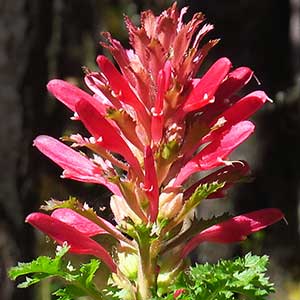Pedicularis densiflora
Pedicularis ornithorhyncha
Indian warrior, warrior's plume
bird's-beak lousewort, ducksbill lousewort
basal 1–10, blade lanceolate, 30–200 x 20–70 mm, 2(or 3)-pinnatifid, margins of adjacent lobes nonoverlapping or extensively overlapping distally, 1-serrate, surfaces glabrous, hispid, or downy;
cauline 4–20, blade lanceolate, 15–250 x 5–100 mm, 2-pinnatifid, margins of adjacent lobes nonoverlapping or extensively overlapping distally, serrate, surfaces glabrous, hispid, or downy.
basal 2–10, blade lanceolate to oblanceolate, 15–80 x 3–10 mm, 1- or 2-pinnatifid, margins of adjacent lobes nonoverlapping or slightly overlapping distally, entire or serrate, surfaces glabrous;
cauline 0–4, blade lanceolate, 5–40 x 3–15 mm, 1- or 2-pinnatifid, margins of adjacent lobes nonoverlapping or slightly overlapping distally, serrate, surfaces glabrous.
simple, 1–5, exceeding basal leaves, each 10–50-flowered;
bracts lanceolate to trullate, 10–35 x 3–5 mm, undivided or 1-pinnatifid, proximal margins entire, distal 1- or 2-serrate, surfaces glabrous.
simple, 1–5, exceeding basal leaves, each 4–15-flowered;
bracts trullate, sometimes lanceolate, 5–13 x 1–3 mm, +/- lobed, margins entire or serrate, surfaces glabrous or tomentose.
2–4 mm.
3–6 mm.
calyx 9–18 mm, downy to tomentose, lobes 5, triangular, 3–4 mm, apex entire, ciliate;
corolla 23–43 mm, tube dark red, purple, or orange-yellow, rarely white, 8–18 mm;
galea dark red, purple, or orange-yellow, rarely white, 15–25 mm, beakless, margins entire medially and distally, apex straight;
abaxial lip dark red, purple, or orange-yellow, rarely white, 8–15 mm.
calyx 6.5–9 mm, tomentose, lobes 5, triangular, 2.5–4 mm, apex entire or serrulate, glabrous or ciliate;
corolla 12–15 mm, tube lavender, 8–9 mm;
galea lavender, 4–6.5 mm, beaked, beak straight, 2–6.5 mm, margins entire medially and distally, apex extending beyond abaxial lip;
abaxial lip pink, 6–8 mm.
= 16.
= 16.
Pedicularis densiflora
Pedicularis ornithorhyncha
Scarlet corollas with an undomed, toothless galea and two- or three-pinnatifid leaves are diagnostic of Pedicularis densiflora. This species occurs in forested subalpine regions of southern Oregon, western slopes of the Sierra Nevada, and the Coast Ranges of California south to Baja California. Herbarium records indicate northern populations of P. densiflora occur at higher elevations than do more southern populations.
(Discussion copyrighted by Flora of North America; reprinted with permission.)
Pedicularis ornithorhynchos is commonly misspelled in the literature as P. ornithorhyncha. As this is the orthography used in floras since C. L. Hitchcock et al. (1955–1969, vol. 4), it also appears on recent herbarium specimens. How this error arose is unclear because the same misspelling also appears on specimens older than 1959. Another occasional misspelling is ornithorhynchus.
The galeas of Pedicularis ornithorhynchos taper into long conical, uncoiled beaks that are very conspicuous above the horizontally expanded lateral lobes of the abaxial lips. No more than 15 flowers are borne on the capitate heads, with the internodes greatly expanding as the fruits develop. Compared to the basal leaves, the cauline leaves of the inflorescence are very few and much shorter, but otherwise similar in form. This alpine and tundra species occurs in the Alaskan panhandle and Coast Mountains as well as the coast ranges of mainland British Columbia south into the northern Cascade Range as far south as Mount Rainier; it is also recorded from alpine areas on Vancouver Island and the Haida Gwaii (Queen Charlotte Islands), British Columbia.
Pedicularis ornithorhynchos is pollinated by bumblebees that hang inverted from the galea and cause release of pollen by wing-muscle vibrations (L. W. Macior 1973).
(Discussion copyrighted by Flora of North America; reprinted with permission.)


